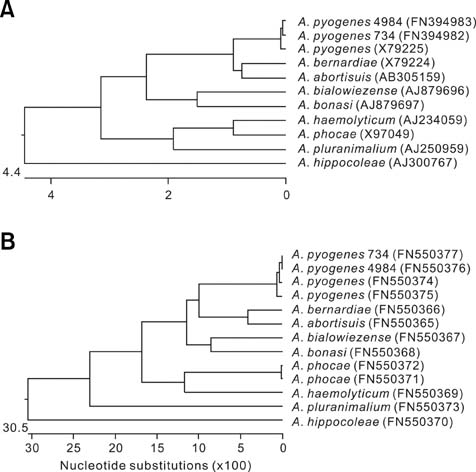J Vet Sci.
2010 Sep;11(3):265-267. 10.4142/jvs.2010.11.3.265.
Identification of Arcanobacterium pyogenes isolated by post mortem examinations of a bearded dragon and a gecko by phenotypic and genotypic properties
- Affiliations
-
- 1Institut fur Pharmakologie und Toxikologie, Justus-Liebig-Universitat Giessen, Frankfurter Str. 107, 35392 Giessen, Germany. Christoph.Laemmler@vetmed.uni-giessen.de
- 2GD Animal Health Service, Department of Bacteriology and Parasitology, Postbus 9, 7400 AA Deventer, The Netherlands.
- 3Institut fur Tierarztliche Nahrungsmittelkunde, Justus-Liebig-Universitat Giessen, Frankfurter Str. 92, 35392 Giessen, Germany.
- 4Institut fur Hygiene und Infektionskrankheiten der Tiere, Justus-Liebig-Universitat Giessen, Frankfurter Str. 85-91, 35392 Giessen, Germany.
- 5Landesbetrieb Hessisches Landeslabor, Schubertstr. 60, 35392 Giessen, Germany.
- KMID: 1093502
- DOI: http://doi.org/10.4142/jvs.2010.11.3.265
Abstract
- The present study was designed to identify phenotypically and genotypically two Arcanobacterium (A.) pyogenes strains isolated by post mortem examinations of a bearded dragon and a gecko. The A. pyogenes strains showed the typical biochemical properties and displayed CAMP-like synergistic hemolytic activities with various indicator strains. The species identity could be confirmed genotypically by amplification and sequencing of the 16S rDNA gene and, as novel target gene, by sequencing of the beta subunit of RNA polymerase encoding gene rpoB, of both strains and of reference strains representing nine species of the genus Arcanobacterium. The species identity of the two A. pyogenes strains could additionally be confirmed by PCR mediated amplification of species specific parts of the 16S-23S rDNA intergenic spacer region, the pyolysin encoding gene plo and by amplification of the collagen-binding protein encoding gene cbpA. All these molecular targets might help to improve the future identification and further characterization of A. pyogenes which, as demonstrated in the present study, could also be isolated from reptile specimens.
Keyword
MeSH Terms
Figure
Reference
-
1. Billington SJ, Jost BH, Cuevas WA, Bright KR, Songer JG. The Arcanobacterium (Actinomyces) pyogenes hemolysin, pyolysin, is a novel member of the thiol-activated cytolysin family. J Bacteriol. 1997. 179:6100–6106.
Article2. Billington SJ, Post KW, Jost BH. Isolation of Arcanobacterium (Actinomyces) pyogenes from cases of feline otitis externa and canine cystitis. J Vet Diagn Invest. 2002. 14:159–162.
Article3. Ertaş HB, Kiliç A, Özbey G, Muz A. Isolation of Arcanobacterium (Actinomyces) pyogenes from abscessed cattle kidney and identification by PCR. Turk J Vet Anim Sci. 2005. 29:455–459.4. Esmay PA, Billington SJ, Link MA, Songer JG, Jost BH. The Arcanobacterium pyogenes collagen-binding protein, CbpA, promotes adhesion to host cells. Infect Immun. 2003. 71:4368–4374.
Article5. Hassan AA, Mohyla H, Kanbar T, Alber J, Lämmler C, Abdulmawjood A, Speck S, Zschöck M, Weiss R. Molecular identification of Arcanobacterium bialowiezense and Arcanobacterium bonasi based on 16S-23S rRNA intergenic spacer region sequences. Vet Microbiol. 2008. 130:410–414.
Article6. Hassan AA, Ülbegi-Mohyla H, Kanbar T, Alber J, Lämmler C, Abdulmawjood A, Zschöck M, Weiss R. Phenotypic and genotypic characterization of Arcanobacterium haemolyticum isolates from infections of horses. J Clin Microbiol. 2009. 47:124–128.
Article7. Jost BH, Billington SJ. Arcanobacterium pyogenes: molecular pathogenesis of an animal opportunist. Antonie van Leeuwenhoek. 2005. 88:87–102.
Article8. Khamis A, Raoult D, La Scola B. rpoB gene sequencing for identification of Corynebacterium species. J Clin Microbiol. 2004. 42:3925–3931.
Article9. Kuhnert P, Capaul SE, Nicolet J, Frey J. Phylogenetic positions of Clostridium chauvoei and Clostridium septicum based on 16S rRNA gene sequences. Int J Syst Bacteriol. 1996. 46:1174–1176.
Article10. Lämmler C, Hartwigk H. Blobel H, Schlieβer T, editors. Actinomyces pyogenes und Arcanobacterium haemolyticum. Handbuch der bakteriellen Infektionen bei Tieren. 1995. Jena: Gustav Fischer Verlag;196–240.11. Silva E, Gaivão M, Leitão S, Jost BH, Carneiro C, Vilela CL, Lopes da Costa L, Mateus L. Genomic characterization of Arcanobacterium pyogenes isolates recovered from the uterus of dairy cows with normal puerperium or clinical metritis. Vet Microbiol. 2008. 132:111–118.
Article12. Ülbegi-Mohyla H, Hassan AA, Kanbar T, Alber J, Lämmler C, Prenger-Berninghoff E, Weiss R, Siebert U, Zschöck M. Synergistic and antagonistic hemolytic activities of bacteria of genus Arcanobacterium and CAMP-like hemolysis of Arcanobacterium phocae and Arcanobacterium haemolyticum with Psychrobacter phenylpyruvicus. Res Vet Sci. 2009. 87:186–188.
Article
- Full Text Links
- Actions
-
Cited
- CITED
-
- Close
- Share
- Similar articles
-
- Genotypic and Phenotypic Analysis Among Clinical Isolate of Streptococcus pyogenes in Seoul , Korea
- The Forensic Pathology in Scotland and the Analysis of Post-mortem Examinations at Glasgow
- Basic Concepts of Bacterial Taxonomy
- Erythromycin Resistance Phenotype of Streptococcus pyogenes
- Lemierre Syndrome Caused by Arcanobacterium haemolyticum Alone in a Healthy Man


